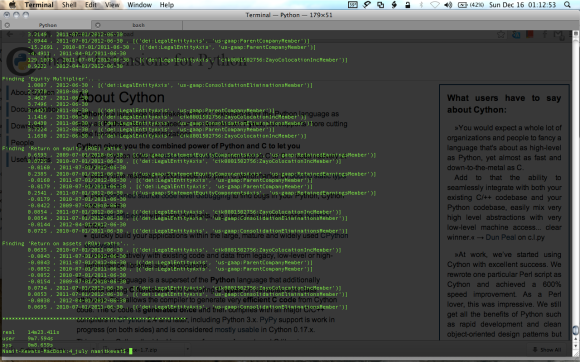XBRL Financial Analytics Platform (Alpha 1.0): First release
Posted on Tue 25 December 2012 in XBRL • Tagged with financial analytics, python, python xbrl, xbrl, xbrl analytics, XBRL Financial Analytics, xbrlfinapp • Leave a comment
Hello friends,
Today i am releasing first alpha release of my xbrl analytics platform.
Its URL is: http://xbrlfinapp.pythonanywhere.com/
Its a web application, targeting users whose XBRL is on SEC/or not on SEC/or not in public domain yet/or anyone who is interested in XBRL data and want to do the financial analytics.
At present it is only working for US-GAAP TAXONOMY VERSIONS 09,11,12.
Website's layout and design is simple; just upload valid zipped xbrl package and see the result on Homepage only. Upload file size has limit of 5MB. If you want to increase that limit then please show me that xbrl.
Limited numbers of financial formulas(Key performance Indicators) have been included; because current website design and hosting type is restricting them. But these formulas are using data from XBRL package only; no access to market information(like; share price).
Well, all those improvements are in progress.
This app represents final analysed data in form of table;similar how arelle is loading xbrl file. But its not. It is doing complex algorithm of data finding.
For example; consider two cases as; 1st: " Correctly determining what total equity is if an SEC filer does not provide total equity" 2nd: "Correctly determining what total revenues is when the filer does not provide total revenues or when they use obscure concepts to express revenues"
Lets take this challenge to my app; first download one xbrl filling from SEC from here and upload it to xbrlfinapp application.
case 1. Filler has not provided total equity concept("us-gaap_StockholdersEquity"); and my application has find out its three components, they are: RetainedEarningsAccumulatedDeficit, CommonStockValue, AccumulatedOtherComprehensiveIncomeLossNetOfTax.
case 2. Filler has not provided 'total revenues' concept('us-gaap_Revenues'); and then in such case my application has find out its two components, they are; InterestExpense, SalesRevenueNet
Similarly filler has not provided 'Pre-Tax Income Loss'
concept('us-gaap_IncomeLossFromContinuingOperationsBeforeIncomeTaxesExtraordinaryItemsNoncontrollingInterest');
and then my application has find out its two components, they are; IncomeLossFromEquityMethodInvestments, IncomeLossFromContinuingOperationsBeforeIncomeTaxesMinorityInterestAndIncomeLossFromEquityMethodInvestments.
Other cases like; filer has not provided 'Total Costs and Expenses'
concept (us-gaap_CostsAndExpenses) and then my application has find out
its five components
as; InterestExpense, CostOfGoodsSold, OtherPostretirementBenefitExpense, SellingGeneralAndAdministrativeExpense, PensionExpense.
but Current Assets(us-gaap_AssetsCurrent),Current liabilities(us-gaap_LiabilitiesCurrent), Total Assets(us-gaap_Assets) ,Operating Income Loss(us-gaap_OperatingIncomeLoss) are present; so they are not recalculated again.
By this way; you can upload any xbrl package from SEC(under UGT version 09,11,12).
Also there might be some bug or error in doing analysis; if you find them then please inform me at 'namitkewat@gmail.com'




